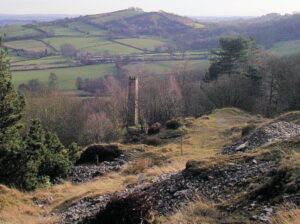Gregory mine was once one of the most productive lead mines in England.
In 1734 the Nether Sough Company was formed to exploit the vein owned by the Gregory family of Ravensnest Farm. By 1767 the output topped 1,000 tons and profits for the year 1772 were a remarkable £15,024 8s.10d.
Between 1758 and 1806 this highly productive mine yielded an average of 511 tons of ore per annum, and shareholders had a clear profit of £100,000 after spending £23,000 on prospecting for a new vein.
This gives some idea of the magnitude and importance of the lead mining industry in Ashover in the eighteenth century.
Several steam engines were installed and worked by the Thompson family. The shaft north-west of Ravensnest House was 120 yd deep, that at New Engine, west of Cocking Tor, 365 yd deep.
In 1768 the first Steam Engine was erected to lift the mine flood water to the sough by means of slide rods. The engine was of the early Newcomen atmospheric type designed by local engineer Francis Thompson (who lived at Hill House in Ashover) and consumed coal at the rate of 26 tons per week.
By 1779 flooding in the Gregory Mine had worsened and Thompson’s engine could not cope. An order was placed with the Boulton and Watt Company of Soho, Birmingham for one of their more efficient steam pumping engines which was erected above Cocking Tor on the site now occupied by Old Engine Farm. In 1784 a general decline in the Ashover lead mining industry began. In the Gregory Mine both output and profits were substantially reduced due to the impoverishment of the vein and the costs which had been incurred during the search for richer ore. A last attempt to make the mine profitable was made in 1790 when a new shaft was commenced to the west of New Engine Shaft. In 1797 a new vein was discovered but it was not enough to offset previous losses.
Finally in 1803, after having been worked for over 250 years, the Gregory Mine was closed. The extent of excavation along the vein was marked on the surface by a stone post bearing the initial “G.E. 1803” in fine carving but this has, unfortunately, disappeared.
The Old Engine from Gregory Mine was moved to Westedge Mine which was situated on the hill opposite Butts Quarry.
The chimney is listed as a GII building by Historic England

